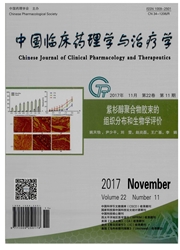

 中文摘要:
中文摘要:
目的:研究EPHX2 rs1042032(A/G)多态性与长沙地区汉族人群脑梗塞继发性癫痫遗传易感性关联关系。方法:收集中南大学湘雅医院及湘雅三医院脑梗塞未继发癫痫及脑梗塞继发癫痫患者血液标本。利用病例-对照研究方法,将标本分为对照组(即无EP组)402例和病例组(即EP组)124例,提取血样的DNA。然后根据人类基因组DNA序列,设计EPHX2 rs1042032 PCR引物,用PCR方法对目的基因EPHX2进行扩增。通过聚合酶链反应-限制性片段长度多态性(PCR-restriction fragment length polymorphism,PCR-RFLP)方法,先对扩增的目的基因片段进行酶切,然后通过凝胶电泳对不同的等位基因进行分辨。结果:EP组和无EP组间EPHX2 rs1042032多态位点基因型分布无显著统计学差异(P〉0.05)。结论:EPHX2 rs1042032的基因多态性与脑梗塞继发性癫痫可能无关。
 英文摘要:
英文摘要:
Objective: To explore EPHX2 polymorphism and post-stroke epilepsy susceptibility in Changsha Han population.Methods: Using a case-control study, we collected the blood samples from 402 stroke patients without epilepsy and 124 post-stroke epilepsy patients in Xiangya Hospital and The Third Xiangya Hospital of Central South University. The subjects were divided into case group(EP group) and the control group(non EP group), genomic DNA were extracted from blood samples. Then, we designed EPHX2rs1042032 PCR primers according to the DNA sequence of the human genome, the target gene EPHX2 was amplified by PCR. By polymerase chain reaction restriction fragment length polymorphism(PCR-RFLP) method, the PCR products were digested by restriction endonuclease Bse GⅠ, restricted DNA products were then separated by using 3% agarose gel electrophoresis and visuslized by UV light.Results: The frequency distribution of EPHX2 rs1042032 between EP group and non EP group was not significantly different.Conclusion: The data suggests that EPHX2 rs1042032 may not be associated with post-stroke epilepsy.
 同期刊论文项目
同期刊论文项目
 同项目期刊论文
同项目期刊论文
 Association of GSTM1 null polymorphism with isosorbide-5-mononitrate cardiovascular response and inv
Association of GSTM1 null polymorphism with isosorbide-5-mononitrate cardiovascular response and inv 期刊信息
期刊信息
